Compared to electric cars, e-bikes produce far fewer emissions overall, mainly because their manufacturing is much simpler and cleaner—around 0.6 tonnes CO₂ per bike versus 17 tonnes for a car. During use, e-bikes emit just 1-2 grams per kilometer, while cars release about 130 grams. Recycling batteries and choosing renewable energy further cut their environmental impact. To explore how these differences make e-bikes a greener option, keep exploring the details.
Key Takeaways
- E-bikes produce approximately 0.6 tonnes CO₂e over their lifecycle, about 33 times less than electric cars’ 17 tonnes.
- Manufacturing emissions for e-bikes are minimal (~0.6 tonnes CO₂), whereas electric cars emit around 17 tonnes, mainly from raw materials and assembly.
- E-bikes emit only 1-2 grams CO₂ per km during use, compared to 130 grams from electric cars, significantly reducing operational emissions.
- Battery production for e-bikes is simpler and highly recyclable (~95%), lowering environmental impact compared to electric car batteries.
- Replacing short trips with e-bikes can cut urban CO₂ emissions by up to 45%, while electric cars contribute substantially more over their lifespan.
Manufacturing Footprint of E‑Bikes and Electric Cars

Manufacturing an electric car produces roughly 33 times more CO2 emissions than making an e-bike, mainly because of its larger size, complexity, and the amount of resources required. This difference highlights the stark contrast in manufacturing emissions between electric vehicles and smaller transport options like e-bikes. Producing a typical electric car, such as a Ford Mondeo, emits around 17 tonnes of CO2, while an e-bike with a 500 Wh battery results in just about 0.6 tonnes, including battery production. The manufacturing process for electric vehicles involves extensive use of materials like aluminum, which, although energy-intensive, can be offset by high recycling rates. Additionally, understanding manufacturing footprints can help consumers make more sustainable transportation choices. A detailed analysis of material extraction reveals further environmental impacts associated with the production of EV components. Moreover, energy consumption during manufacturing significantly influences the overall emissions profile of electric vehicles. Overall, the smaller scale and simpler design of e-bikes contribute considerably to their lower manufacturing footprint compared to electric cars. Moreover, innovations in recycling technologies are helping to reduce the environmental impact of vehicle production even further.
Emissions During Production: Key Numbers

Producing an electric car results in markedly higher CO2 emissions than making an e-bike, with a typical vehicle emitting around 17 tonnes of CO2e compared to less than 1 tonne for an e-bike. This difference stems from raw material extraction, assembly, and transportation, which greatly increase the carbon footprint of car manufacturing. To highlight this disparity, consider the following:
| Vehicle Type | Emissions During Production |
|---|---|
| Electric Car | ~17 tonnes CO2e |
| E-bike | < 1 tonne CO2e |
| Battery Emissions | 59 kg CO2e per kWh |
These numbers clearly show that the carbon footprint of car production is considerably larger, mainly due to complex assembly lines and resource use, resulting in higher emissions per vehicle. Additionally, the resource-intensive manufacturing processes contribute significantly to the overall emissions associated with electric cars. The extraction and processing of raw materials, such as lithium, cobalt, and rare earth elements, also play a crucial role in increasing emissions during the production phase. Furthermore, the material extraction process involves significant energy consumption, further amplifying the environmental impact.
Lifecycle Emissions: Comparing Total Carbon Footprints
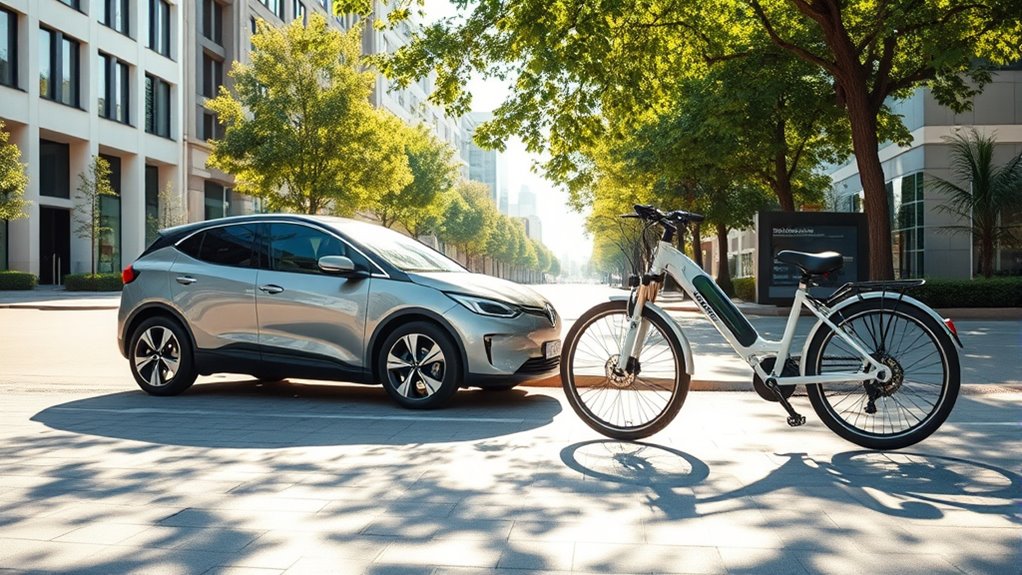
When considering the full environmental impact of transportation options, electric cars generate roughly 33 times more lifecycle emissions than e-bikes, mainly due to higher manufacturing energy and resource use. The carbon footprint of an electric car includes intense resource extraction, complex assembly, and significant energy consumption during production. In contrast, e-bikes have a much smaller lifecycle emissions footprint because their manufacturing process is simpler and requires fewer resources. Additionally, e-bikes have higher end-of-life recycling rates, further reducing their overall environmental impact. Over their lifespan, electric cars produce a vastly larger carbon footprint, from manufacturing through disposal. This makes e-bikes a much more sustainable choice for short-distance transportation, with lower lifecycle emissions that benefit both the environment and your personal carbon footprint. The development of sustainable recycling practices is crucial for minimizing the environmental impact of electric vehicle components.
Energy Sources and Their Impact on Battery Emissions
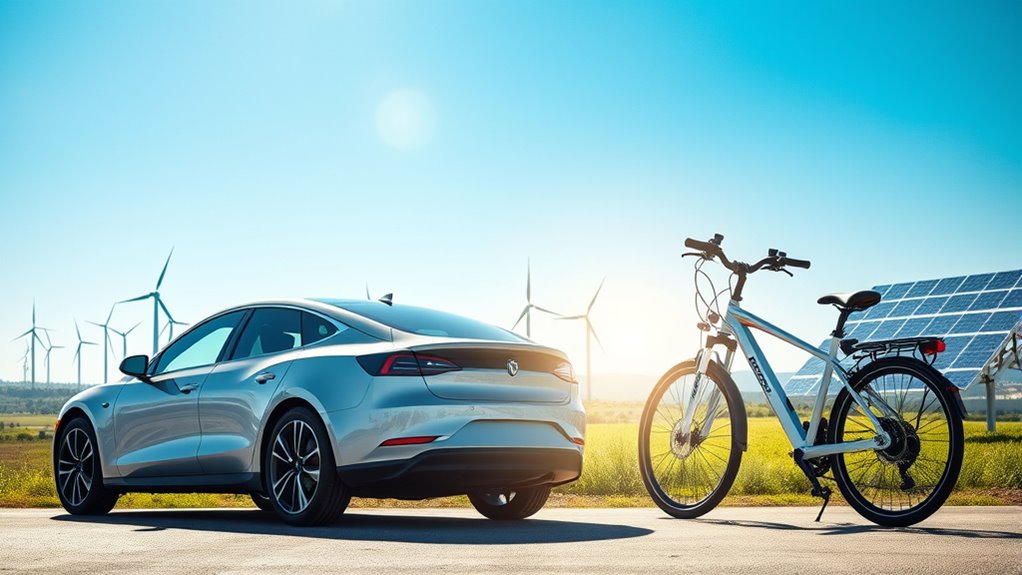
Have you ever wondered how the electricity used to charge your e-bike affects its overall emissions? The answer depends on the electric grid’s energy mix. If your region relies heavily on fossil fuels, the carbon emissions from manufacturing and charging your battery increase markedly. E-bike batteries produce about 59 kg CO₂e per kWh, meaning cleaner energy sources can cut emissions by reducing the carbon footprint. Manufacturing a 500 Wh battery adds roughly 30 kg of CO₂, but this impact drops when powered by renewable energy. The environmental benefits are maximized in areas with a high share of renewable sources, lowering both carbon emissions during manufacturing and the emissions from charging. Using renewable energy sources for charging can significantly enhance the sustainability of electric vehicles. Additionally, regions with diverse beach town experiences often have access to cleaner energy options, further reducing emissions associated with electric transportation. Implementing smart grid technologies can optimize energy distribution, further decreasing overall emissions. Furthermore, supporting policies that promote renewable energy development can lead to a cleaner energy grid and lower transportation-related emissions.
Operational Emissions: Riding vs. Driving
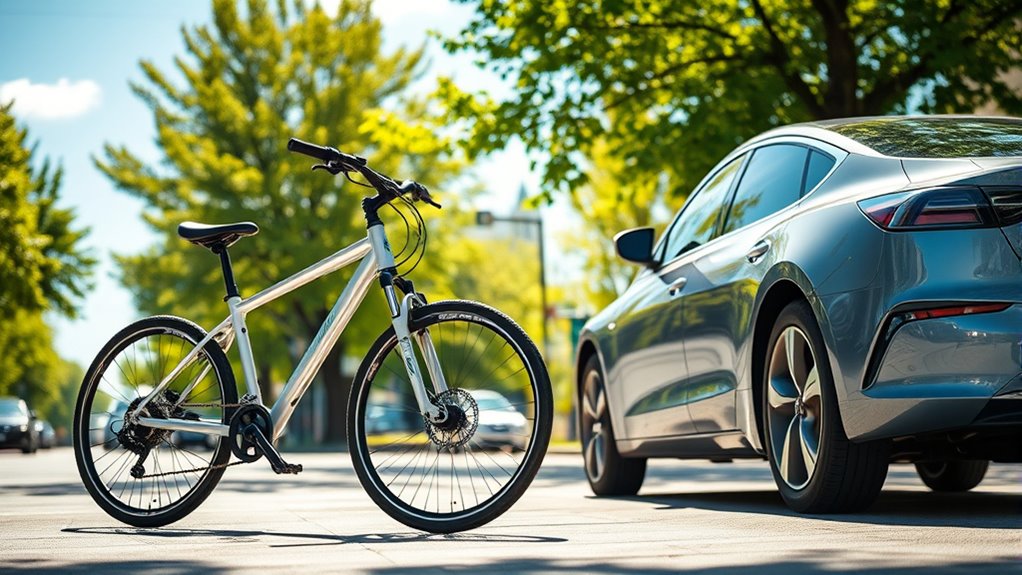
When you ride an e-bike, your emissions are almost negligible compared to driving a car, which releases large volumes of exhaust gases and pollutants. Electric bikes produce very little local air pollution and no noise, while cars emit significant greenhouse gases and toxic substances. Overall, your riding results in just a tiny fraction of the emissions generated by driving. Additionally, utilizing an e-bike can be an effective way to reduce your carbon footprint and contribute to cleaner air. The reduced environmental impact of e-bikes is also supported by their low energy consumption, making them a sustainable transportation option. Moreover, the efficiency of electric motors in e-bikes aligns with Volkswagen Tuning principles of optimizing performance while minimizing environmental impact. By choosing e-bikes over traditional vehicles, users can further decrease vehicle emissions and promote eco-friendly transportation.
Emission Levels During Use
E-bikes produce vastly lower emissions during operation compared to cars, making them a cleaner choice for daily transportation. When you ride an e-bike, your carbon emissions are typically just 1-2 grams per kilometer if charged with fossil-fuel electricity, whereas cars emit around 130 grams per kilometer. This huge difference means e-bikes contribute minimally to air pollution and toxic gases. Additionally, since e-bikes release negligible pollutants during use, they markedly support emission reduction efforts. The environmental impact during riding is minimal, especially when powered by renewable energy. In contrast, car engines release large volumes of hot gases and pollutants, making them far less eco-friendly. Choosing an e-bike helps lower your carbon footprint and promotes cleaner air, supporting a sustainable future. Proper soil conditions are also essential for maintaining the health of electric bikes’ batteries, ensuring optimal performance and longevity. Regular filter maintenance can further improve the efficiency and lifespan of the batteries and other components. Moreover, implementing smart charging practices can further reduce the environmental impact of e-bikes by using renewable energy sources.
Gas Release Volumes
Did you know that the volume of gases released during operation varies dramatically between e-bikes and cars? When you drive an electric car, it releases about 180 cubic meters of gases per hour, including carbon dioxide, water vapor, and toxic substances. This results in a substantial gas release volume, contributing considerably to environmental impact. In contrast, riding an e-bike produces minimal emissions, mainly from electricity generation, which can be nearly zero if renewable sources power it. The difference in gas release volumes is staggering—cars emit hundreds of times more CO₂ and other gases per kilometer traveled. So, while driving releases large volumes of gases like carbon dioxide into the atmosphere, e-bikes keep those gas releases comparatively tiny, making them a cleaner, greener choice for reducing your environmental footprint. Additionally, appliance energy efficiency plays a vital role in reducing overall emissions associated with electricity generation.
Environmental Benefits of E‑Bikes in Urban Settings

E-bikes help cut down on urban traffic, making city commutes smoother and faster. They emit far fewer pollutants, improving air quality and reducing overall city emissions. Plus, their small size means they take up less space, easing congestion and freeing up parking for other vehicles.
Reduced Traffic Congestion
Because they replace many short car trips, e-bikes can considerably ease urban traffic congestion. When you choose an e-bike for quick errands or commutes, you help reduce traffic congestion during peak hours. This shift means fewer cars on the road, less road space used per traveler, and smoother urban mobility. E-bikes require less parking space, freeing up valuable urban areas and decreasing congestion caused by parking searches. As more people adopt e-bikes, city streets experience less traffic density, making commutes faster and more efficient. By moving short-distance trips from cars to e-bikes, you contribute to alleviating traffic jams and improving overall traffic flow in your city. This simple switch benefits everyone by making urban transportation more manageable and less congested.
Lower Urban Emissions
Switching to e-bikes in urban areas can substantially lower emissions and improve air quality. Electric bikes produce just 1-2 grams of CO₂ per kilometer, far less than the 130 grams emitted by typical cars. This significant reduction helps decrease toxic gases like NOx and particulate matter such as PM2.5, which are major pollutants in cities. Using e-bikes for short trips reduces traffic congestion and decreases parking demand, further improving air quality. Manufacturing emissions for e-bikes are minimal compared to cars, and their overall carbon footprint remains low. Shifting urban short-distance travel from cars to electric bikes can cut local emissions by up to 7%. This change not only benefits the environment but also promotes healthier, cleaner city air for everyone.
Space-Efficient Transportation
In urban settings, e-bikes offer a highly space-efficient alternative to traditional transportation options. They require only about 10% of the parking and roadway space needed for equivalent travel, helping reduce urban congestion. Their smaller size and lighter weight cause less wear on roads, lowering maintenance costs and extending infrastructure lifespan. The compact design makes e-bikes easy to integrate into existing city environments, enabling flexible parking solutions and decreasing the need for large parking lots. By promoting e-bike use, cities can free up space for green areas and pedestrian zones, supporting sustainable land use. Overall, e-bikes contribute to more efficient urban mobility, easing congestion and optimizing available space without sacrificing transportation convenience.
Recycling and End-of-Life Considerations
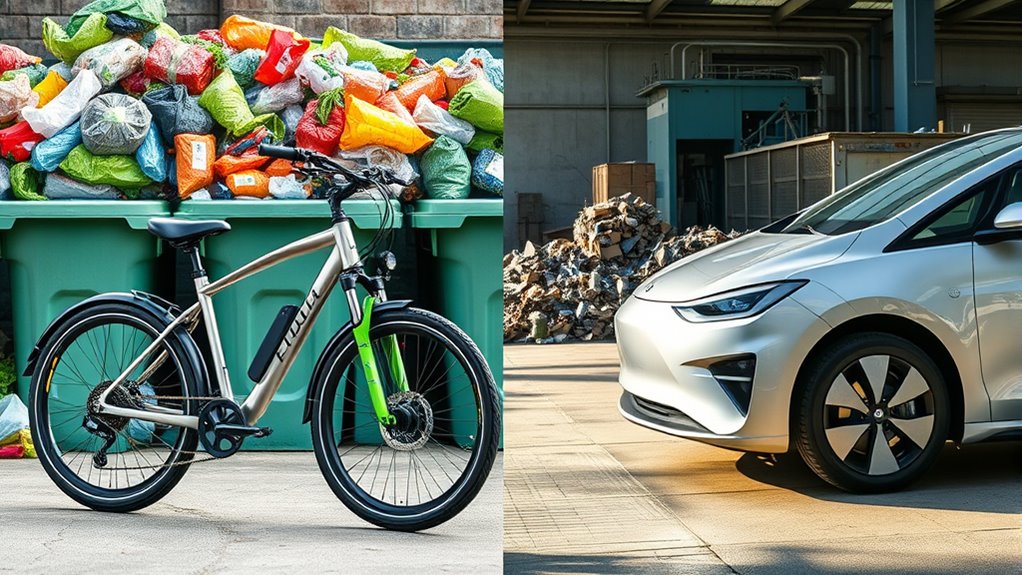
Recycling and end-of-life management play a crucial role in determining the environmental impact of e-bikes and electric cars. About 95% of lithium-ion batteries in e-bikes are recyclable, allowing you to recover valuable materials like lithium, cobalt, and nickel, which reduces the need for raw material extraction. E-bike batteries are simpler to recycle than car batteries, making the process more efficient and environmentally friendly. In contrast, cars in the EU have about 85% recyclability, but their complex components make recycling more challenging. Proper disposal and recycling prevent toxic chemicals from leaching into soil and water, minimizing hazards. Overall, the easier and more effective recycling processes for e-bikes considerably reduce their end-of-life environmental footprint compared to traditional electric vehicles.
Making Sustainable Transportation Choices
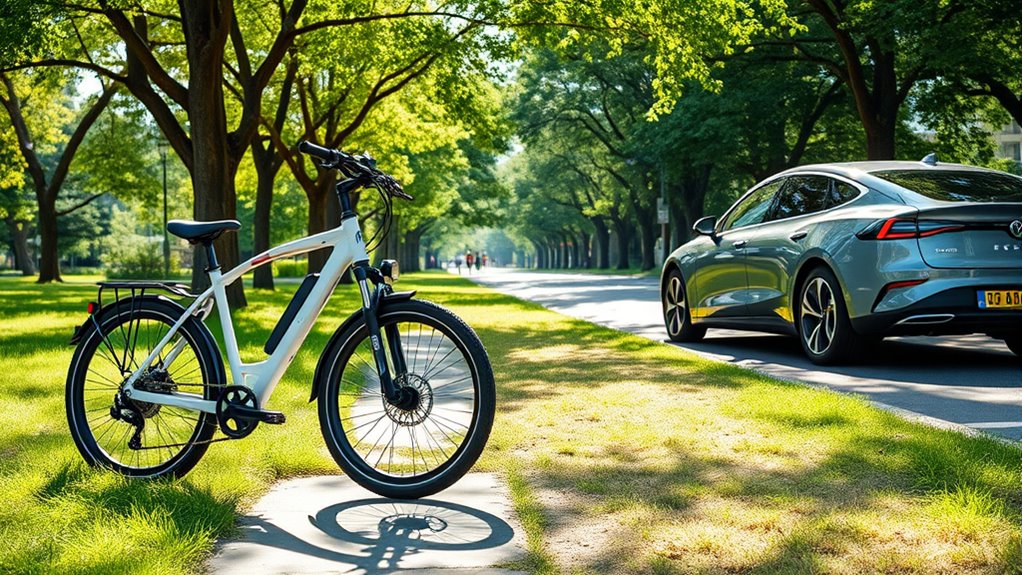
Choosing sustainable transportation options can markedly reduce your carbon footprint and improve urban air quality. Passenger cars produce significant greenhouse gas emissions—about 130 grams per kilometer—contributing heavily to climate change and pollution. In contrast, e-bikes emit just 1-2 grams of CO2 per kilometer, making them a far more eco-friendly choice. Manufacturing and battery production for e-bikes create less overall emissions than electric cars, especially for short trips under six miles, where switching can cut CO2 emissions by up to 45%. Additionally, e-bikes require minimal energy—around $20 annually—boosting cost savings and sustainability. Switching from passenger cars to e-bikes reduces greenhouse gases, urban air pollution, and noise, supporting healthier, cleaner cities and helping you make more environmentally responsible transportation choices.
Frequently Asked Questions
Are Electric Bikes Better for the Environment Than Cars?
You’re wondering if electric bikes are better for the environment than cars. The answer is yes. E-bikes produce far fewer emissions—only about 1-2 grams of CO₂ per kilometer—compared to electric cars’ 130 grams. They also require less energy to manufacture and generate minimal emissions during use. For short trips, choosing an e-bike considerably reduces your carbon footprint and helps protect the environment more effectively than driving an electric car.
Is the Ebike Better Than the Electric Car?
When you ask if an e-bike is better than an electric car, you’re focusing on which is more environmentally friendly. E-bikes produce much less CO2 per kilometer and have a smaller manufacturing footprint. They help cut fossil fuel use more effectively and generate fewer emissions during their lifecycle. So, if you’re considering short to medium trips, an e-bike is generally a cleaner, more sustainable choice for the environment.
Why Are Police Taking Ebikes?
Think of e-bikes as the Swiss Army knives for police. You’re taking advantage of their versatility—cost-effective, eco-friendly, and perfect for maneuvering crowded city streets, parks, or narrow alleys. They’re quieter, helping you approach situations discreetly, and easier to handle on uneven terrains. E-bikes boost response times, cut down on parking issues, and support your agency’s sustainability goals—all while keeping communities safe and connected.
How Much CO2 Is Saved by Electric Cars?
You’re asking how much CO2 electric cars save. Electric cars typically produce 0.1 to 0.5 kg of CO2 per km, much lower than gasoline cars. Over their lifespan, they can cut emissions by 70% or more, especially when powered by renewable energy. Manufacturing emissions are offset within a few years of use, so the longer you drive, the more CO2 you save, making electric cars a cleaner choice overall.
What Are the Disadvantages of Ebikes?
You should know that e-bikes have some drawbacks. Manufacturing and battery production still produce CO2, and resource extraction like mining for lithium and aluminum can harm the environment. They also have limited range and speed, making long trips less practical. Plus, if your electricity comes from fossil fuels, the environmental benefits decrease. Overall, while eco-friendly, e-bikes aren’t perfect and come with notable environmental and practical limitations.
Conclusion
Choosing between an e-bike and an electric car isn’t just about convenience; it’s about the future we want to create. E-bikes offer a greener, more sustainable option for city living, reducing your carbon footprint markedly. But are you willing to make small changes that add up to a healthier planet? Every ride on an e-bike is a step toward a cleaner environment. So, why not choose a greener way today and inspire others to follow?
















